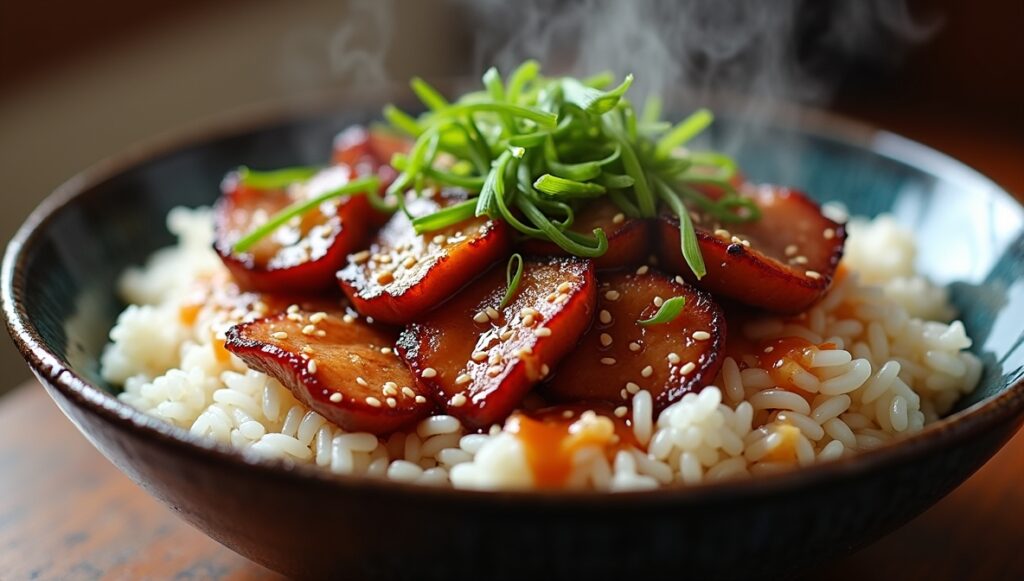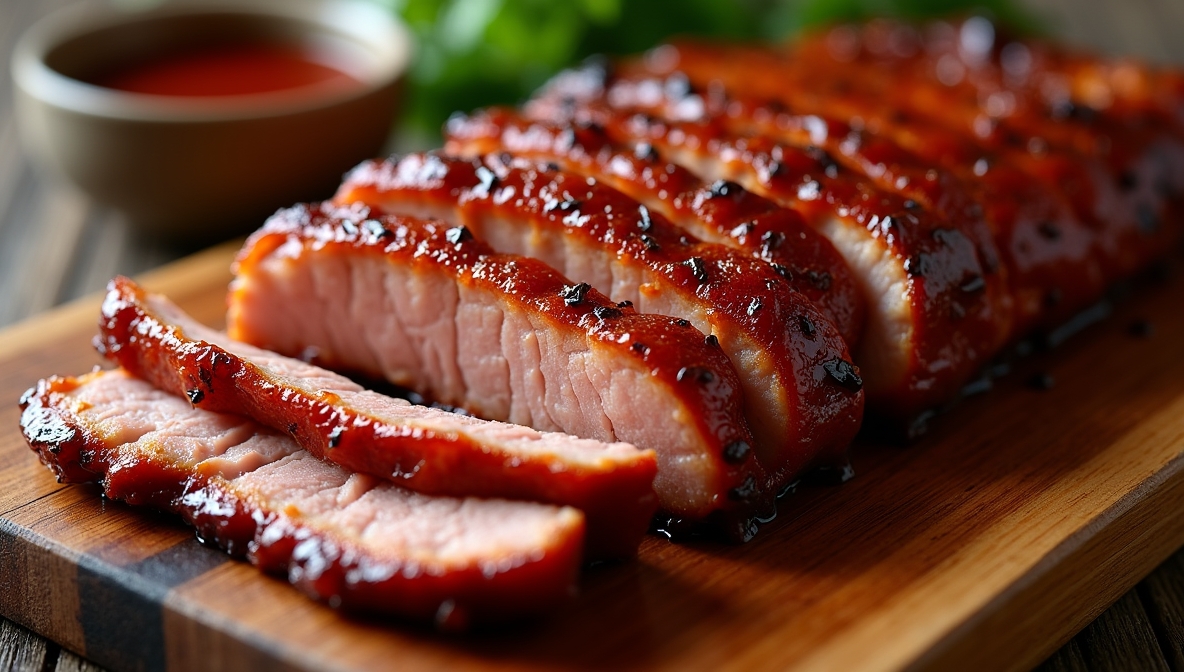Introduction
Char Siu, also known as Cantonese barbecued pork, is one of the most iconic and beloved dishes in Hong Kong cuisine. Its tantalizing aroma, glossy red glaze, and rich, sweet-savory flavor have made it a staple in everything from local roast meat shops to Michelin-starred restaurants. The term “Char Siu” means “fork-roasted” in Cantonese, referencing the traditional method of skewering strips of pork on long forks and roasting them over a fire. This dish is popular not only because of its distinctive taste but also due to its accessibility and versatility—it’s enjoyed with rice, noodles, or even on its own.


History & Cultural Significance
Char Siu has its roots in ancient Chinese culinary practices, dating back to the Qin Dynasty (221–206 BC). The technique of roasting meat over open flames became a hallmark of Cantonese cooking. In Hong Kong, Char Siu evolved into a refined art form, especially during the colonial era, when local chefs began blending Chinese spices with British-inspired sweetness to appeal to broader palates.
It holds deep cultural value in Chinese households and is often featured during family gatherings, ancestral offerings, and festive meals. During the Lunar New Year, it is a common addition to celebratory banquets, symbolizing prosperity due to its vibrant red color.
Ingredients & Regional Variations
Key Ingredients:
Pork shoulder or pork belly (for the perfect balance of fat and meat)
Hoisin sauce
Chinese five-spice powder
Soy sauce (light and dark)
Honey or maltose (for the signature glaze)
Shaoxing wine or rice wine
Red fermented bean curd (for authentic color and umami)
Regional Variations:
While Char Siu remains consistent across Hong Kong, some chefs infuse their own twists—adding extra garlic, tweaking sweetness levels, or marinating the pork for days. In southern China and Southeast Asia, variations may include spicier marinades or different cuts of meat like chicken or duck.
Modern & International Adaptations:
Globally, chefs have incorporated Char Siu into tacos, burgers, and bao buns. In the West, the vibrant red color is sometimes achieved using food coloring rather than traditional fermented bean curd.
Cooking Process & Difficulty Level

Difficulty Level: Moderate
Step-by-Step Cooking Guide:
-
Slice pork shoulder into long strips.
-
In a bowl, mix hoisin sauce, soy sauce, honey, five-spice powder, Shaoxing wine, and bean curd.
-
Marinate pork strips for at least 12 hours or overnight.
-
Preheat oven to 200°C (400°F).
-
Place pork on a rack with a tray beneath to catch drippings.
-
Roast for 20 minutes, then flip and baste with marinade.
-
Roast another 15 minutes until caramelized.
-
For a glossy finish, broil for an additional 5 minutes.
Pro Tip: Let the pork rest before slicing to preserve juiciness.
Where to Eat Char in Hong Kong
-
Joy Hing Roasted Meat (Wan Chai) – A Michelin Bib Gourmand recipient known for its succulent Char Siu.
-
Kam’s Roast Goose (Wan Chai) – Michelin-starred and a hotspot for both Char Siu and roast goose.
-
Yat Lok (Central) – Popular for tourists and locals alike, often has long queues.
-
Tai Hing (Multiple locations) – A chain that offers consistently delicious Char Siu rice plates.
Pairing with Drinks & Side Dishes
Best Drinks:
-
Chinese Jasmine tea
-
Oolong tea
-
Light beers (like Asahi or Tsingtao)
-
Plum wine or dry Riesling
Recommended Side Dishes:
-
Steamed jasmine rice
-
Stir-fried bok choy or choy sum
-
Pickled daikon and carrot
-
Soy sauce noodles
Fun Facts & Lesser-Known Trivia
-
The red color of traditional Char Siu originally came from red fermented bean curd, not artificial dye.
-
In old Hong Kong, Char Siu was sold hanging from street-side hooks, enticing customers with its aroma.
-
Char Siu has even been featured in animated films and comics as a symbol of comfort food.
-
Celebrities like Anthony Bourdain and Gordon Ramsay have praised Hong Kong’s roast meat mastery.
Health Benefits & Nutrition
Nutritional Profile (per 100g):
-
High in protein
-
Rich in B-vitamins (especially niacin and thiamine)
-
Contains healthy fats when made with pork shoulder
Dietary Adaptations:
-
Vegan: Use tofu or seitan and the same marinade.
-
Gluten-Free: Use tamari instead of soy sauce.
-
Keto: Reduce sugar, substitute honey with erythritol.
How to Cook It at Home (Best Char Siu Recipe)
Ingredients:
-
500g pork shoulder
-
2 tbsp hoisin sauce
-
2 tbsp light soy sauce
-
1 tbsp dark soy sauce
-
1 tbsp honey
-
1 tbsp Shaoxing wine
-
1/2 tsp five-spice powder
-
1 cube red fermented bean curd
Cooking Method:
-
Mix all ingredients to form a marinade.
-
Marinate pork for 12 hours.
-
Roast in preheated oven at 200°C for 20 minutes.
-
Flip, baste, roast another 15 minutes.
-
Broil for 5 minutes to finish.
Cooking Tips:
-
Marinate longer for richer flavor.
-
Use a meat thermometer to ensure doneness (internal temp: 145°F/63°C).
Global Influence & Fusion Cuisine
Char Siu has made its way into international street food and gourmet kitchens. In the U.S. and Europe, Char Siu appears in bao buns, tacos, and ramen. Filipino and Malaysian versions use local spices, while chefs in Australia and Canada have turned it into barbecue pizza toppings or fusion rice bowls.
Comparison with Similar Dishes
-
Char Siu vs. Korean Bulgogi: Both are marinated meats, but Bulgogi is typically grilled and uses sesame, pear, and soy flavors.
-
Char Siu vs. American BBQ Pulled Pork: Char Siu is roasted and sweet-glazed, while BBQ pulled pork is slow-cooked and often smoky.
-
Char Siu vs. Middle Eastern Shawarma: Shawarma is spiced and rotisserie-cooked, often served in wraps.

